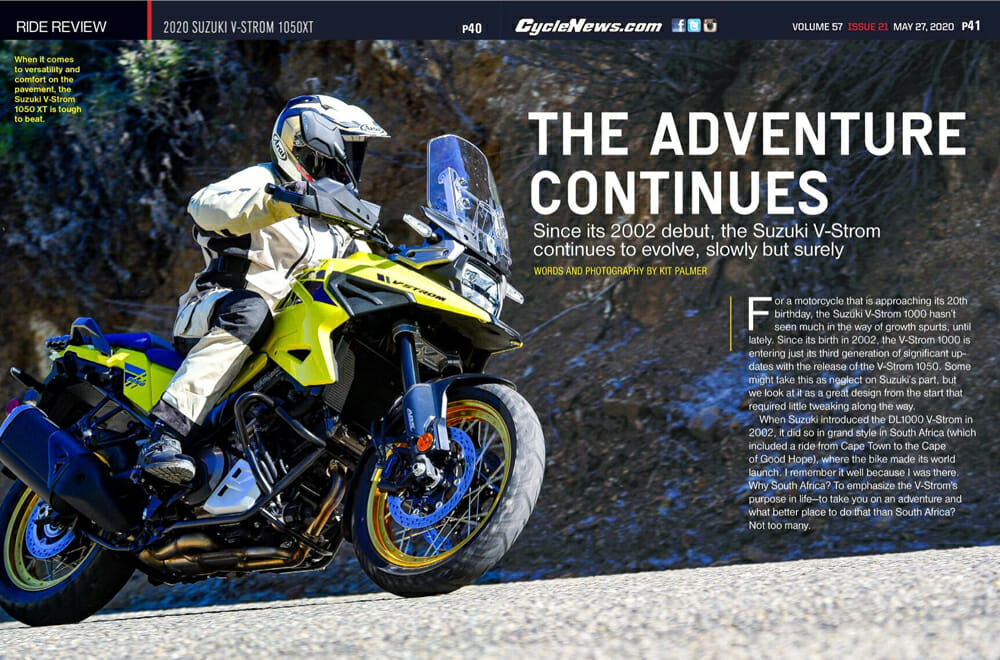Kit Palmer | June 3, 2020
2020 Suzuki V-Strom 1050XT Review
Since its 2002 debut, the Suzuki V-Strom continues to evolve, slowly but surely.
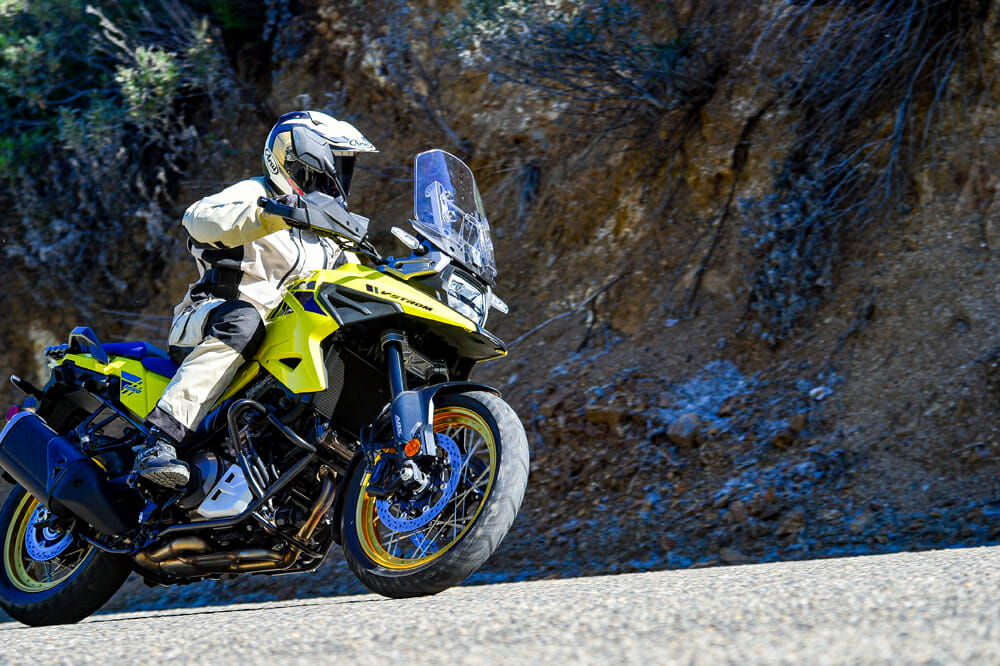 When it comes to versatility and comfort on the pavement, the Suzuki V-Strom 1050 XT is tough to beat.
When it comes to versatility and comfort on the pavement, the Suzuki V-Strom 1050 XT is tough to beat.
Words and Photography by Kit Palmer
For a motorcycle that is approaching its 20th birthday, the Suzuki V-Strom 1000 hasn’t seen much in the way of growth spurts, until lately. Since its birth in 2002, the V-Strom 1000 is entering just its third generation of significant updates with the release of the V-Strom 1050. Some might take this as neglect on Suzuki’s part, but we look at it as a great design from the start that required little tweaking along the way.
When Suzuki introduced the DL1000 V-Strom in 2002, it did so in grand style in South Africa (which included a ride from Cape Town to the Cape of Good Hope), where the bike made its world launch. I remember it well because I was there. Why South Africa? To emphasize the V-Strom’s purpose in life—to take you on an adventure and what better place to do that than South Africa? Not too many.
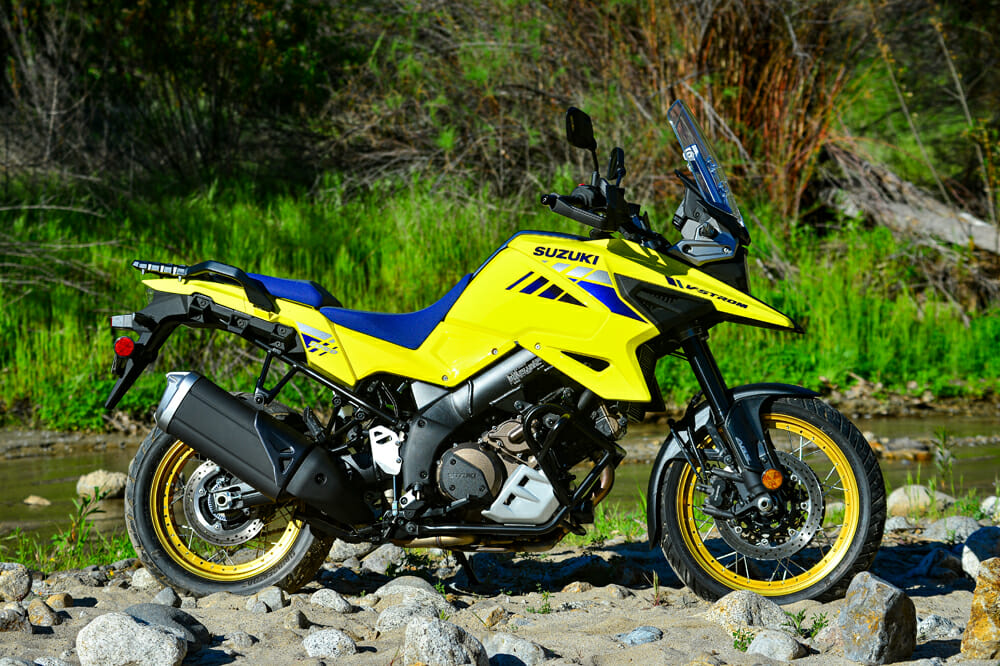 The 1050, with its throwback bright yellow coloring (as well as the bold white/orange option), was inspired by Suzuki’s Ichiro Mayata, who designed Suzuki’s DR-Z Paris-Dakar rally bike in the 1980s.
The 1050, with its throwback bright yellow coloring (as well as the bold white/orange option), was inspired by Suzuki’s Ichiro Mayata, who designed Suzuki’s DR-Z Paris-Dakar rally bike in the 1980s.
The big-bore adventure (ADV) class of motorcycles was pretty much a niche back then, not like it is today. Adventure bikes, or sport enduro touring bikes which Suzuki dubbed the V-Strom back then, were already gaining in popularity in Europe and other parts of the world, thanks to fun land rovers like BMW’s R 1150 GS, Cagiva’s Gran Canyon and Triumph’s Tiger and Suzuki took notice. You have to hand it to Suzuki for being one of the first Japanese manufacturers to recognize this growing category; they saw an opportunity and went for it. So, the V-Strom—the V standing for the bike’s V-twin engine configuration and Strom a German word meaning “a stream of wind”—was born.
The V-Strom was and still is a big hit for the company. It proved to be versatile, a great commuter and a fun and easy motorcycle to ride that could be ridden all day (with or without a passenger) in great comfort. It could also reasonably handle those not-maintained country roads and even embarrass a sportbike rider or two on paved canyon backroads. You could also take the V-Strom on the dirt without feeling guilty. As we soon found out, this bike could take you just about anywhere and do so without completely depleting your bank account, as it sold for just under nine grand when it first came out. That wasn’t cheap, but at least it wasn’t enough to instantly scare off those who were beginning to catch the ADV bug.
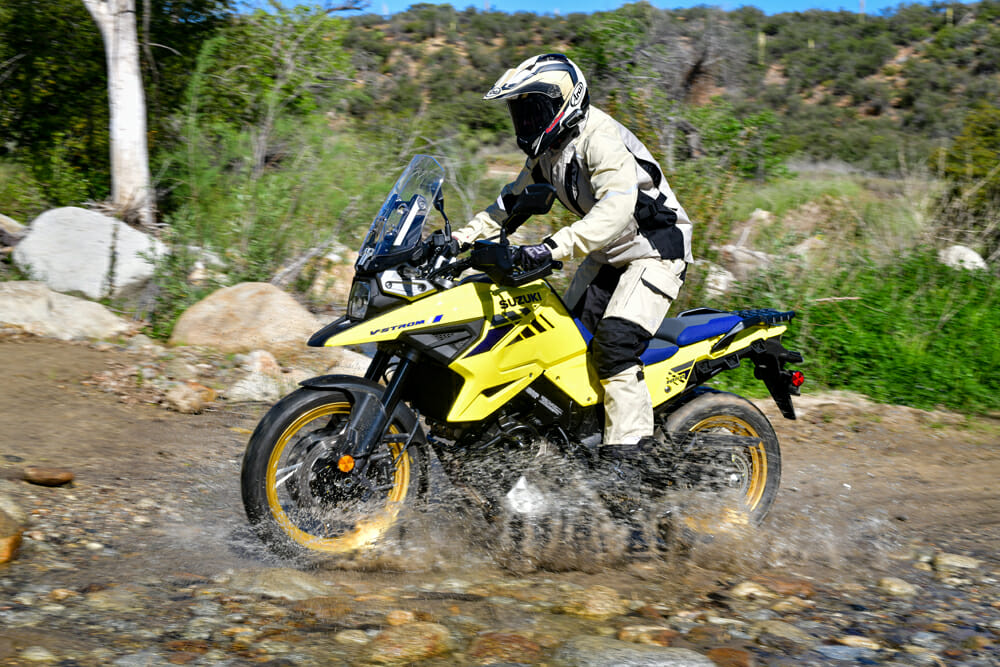 The V-Strom’s calling is the pavement, but it doesn’t mind some light-duty off-roading every now and then.
The V-Strom’s calling is the pavement, but it doesn’t mind some light-duty off-roading every now and then.
The V-Strom took on its first significant overhaul in 2014 when it got, most notably, a larger motor and the company’s first-ever traction-control system. And, of course, it received a much-needed styling update. Four years later, the V-Strom showed up with what Suzuki called Motion Track Anti-lock and Combined Brake System, or, simply put, corning ABS.
Now, for 2020, the V-Strom 1050 got another shot in the arm by getting improved electronics, more rider aids and more power.
You would assume, and rightfully so, that based on its new “1050” moniker, the ’Strom got its power boost due to a bump in displacement, but you would assume incorrectly. Displacement remains the same as before at 1037cc as do bore and stroke at 100 x 66mm, but to satisfy Euro5 emission mandates, Suzuki made updates to the engine (which, by the way, dates back to the old TL1000S days) that made it somehow both cleaner and more powerful. Suzuki’s claimed output has been bumped up from 99 horsepower at 8000 rpm to 106 horsepower at 8500 rpm. Peak torque, however, dropped a bit from 75 lb-ft at 4000 rpm to 74 lb-ft at 6000 rpm. You can contribute this to the engine’s new larger throttle bodies, updated fuel mapping, revised cam timing, higher-compression pistons and a revised exhaust system.
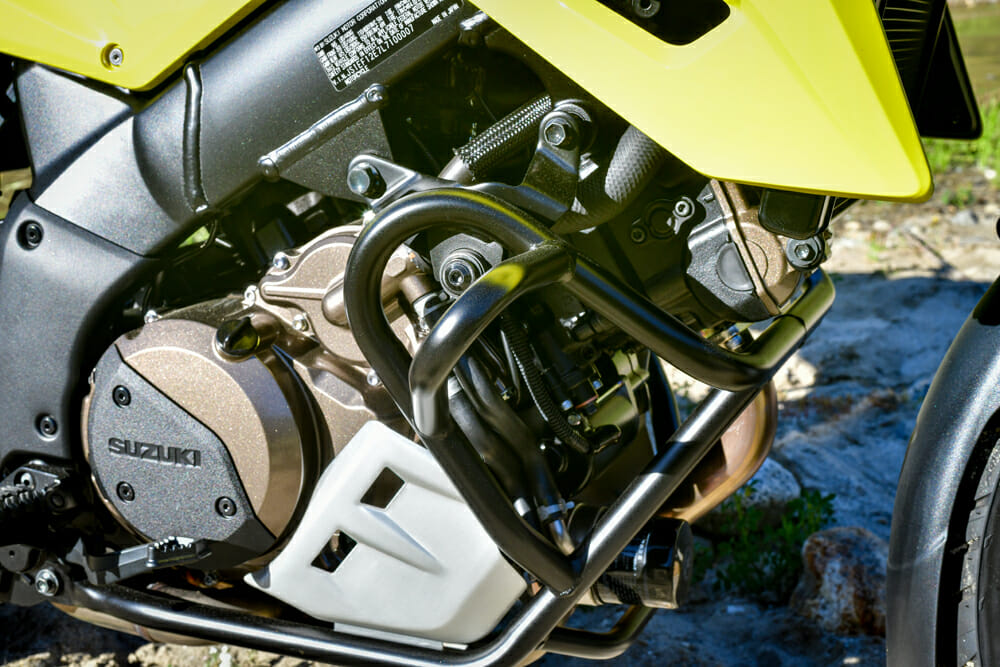 The ’Strom’s engine gets a number of changes for 2020, but an increase in displacement isn’t one of them, despite what it now says on the side of the bike.
The ’Strom’s engine gets a number of changes for 2020, but an increase in displacement isn’t one of them, despite what it now says on the side of the bike.
The new V-Strom also gets a new radiator with 15 percent more capacity and a new liquid-cooled oil cooler located where the oil filter is attached to the engine.
A new ride-by-wire system allows for Suzuki’s new Suzuki Drive Mode Selector (S-DMS). There are three of them: “A” (most aggressive), “B” and “C” modes. Traction control has been updated, as well, with three levels (two presets plus off) now at your fingertips.
Suzuki Intelligent Ride System (S.I.R.S.) is a significant upgrade over the previous model. This electronics package utilizes a new six (formerly five)-axis Bosch IMU. It offers a new cruise control system and plenty of rider aids and conveniences, such as Motion Track Anti-lock and Combination Brake System, Hill Hold Control System, Slope Dependent Control System, Load Dependent Control System, which assists braking performance in a variety of conditions.
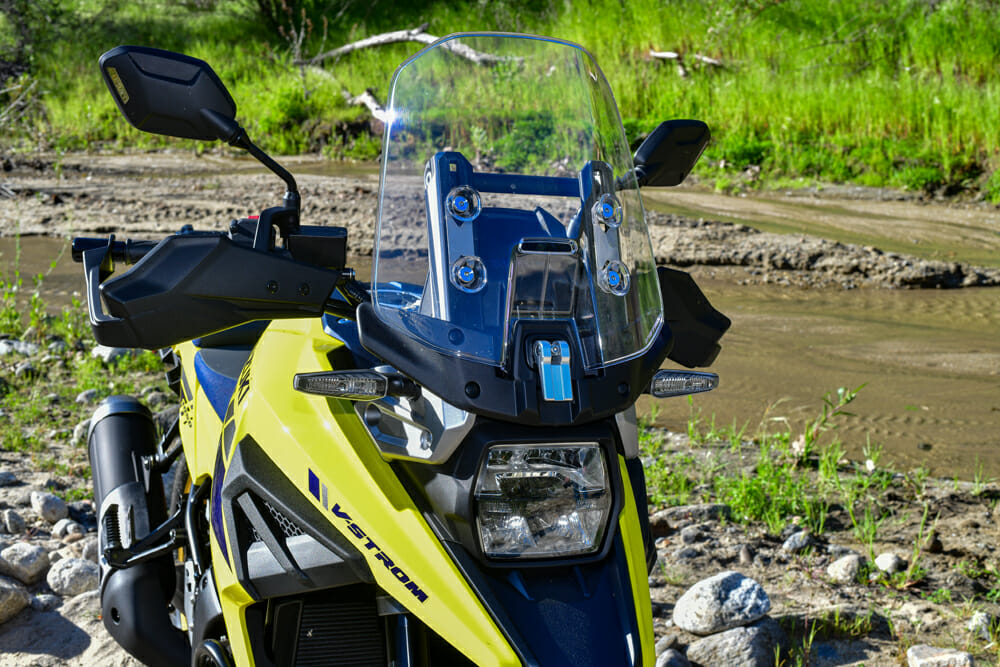 That lever in front of the windscreen is used to adjust its height, so, yes, you have to get off the bike to do it.
That lever in front of the windscreen is used to adjust its height, so, yes, you have to get off the bike to do it.
Other changes to the V-Strom 1050 worth noting include updated LCD instrumentation and LED lighting, new tapered aluminum handlebars that are higher and larger in diameter, wider footpegs, a new two-piece seat that offers height adjustment (33.5 to 34.3 inches) for the pilot, and Bridgestone Battlax Adventure A41 tires.
The aluminum twin-spar frame and KYB suspension, which is still semi-adjustable, feature few changes. There is little less damping up front but a little more in the back. That’s about it.
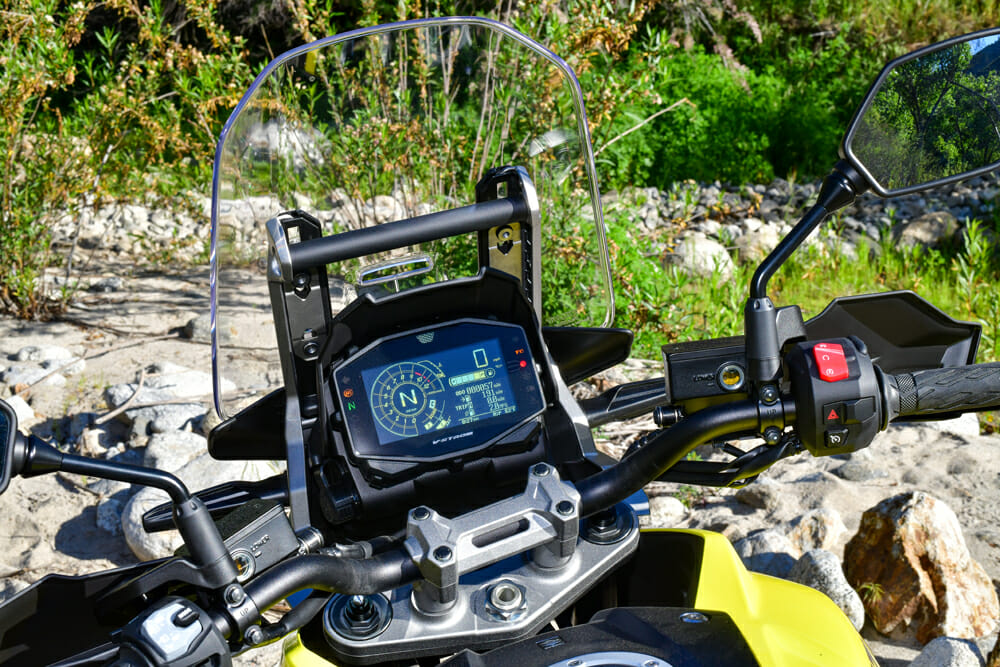 The LCD dash is new, but not new enough. TFT would’ve been cooler (and better).
The LCD dash is new, but not new enough. TFT would’ve been cooler (and better).
There are three variations of the 2020 Suzuki V-Strom 1050 from which to choose: the $13,399 standard model, the $14,799 XT, and the $16,999 XT Adventure. The standard comes in one color (Glass Sparkle Black/Solid Iron Gray) and has cast wheels and no S.I.R.S. Move up a level to the XT, and you get quite a bit more: S.I.R.S, spoked wheels, an adjustable seat, a center stand, engine guards, a lower cowl, an adjustable windscreen, more stylish mirrors and handguards, and two color options: eye-catching Champion Yellow No. 2 with a blue seat and accents, and Pearl Brilliant White/Glass Blaze orange. The top-of-the-line XT Adventure is essentially an XT with quick-release panniers and heated grips. Like the standard, the XT Adventure is only offered in black, which seems odd to me when the yellow and orange XTs look so, well, awesome!
Of course, Suzuki also offers a ton of accessories for the V-Strom, so if you want the pretty ‘Stroms, you can purchase one of the XTs and buy the panniers—and heated grips—later (which is what I would do without a second thought.)
Despite all of the changes, in motion, the V-Strom is still a V-Strom at heart, which is a good thing. It’s still extremely comfortable and solid as a rock at speed. In my opinion, there just isn’t a motorcycle more comfortable to ride on the street than the V-Strom, except for perhaps a Honda Gold Wing (even then). Luckily, nothing has changed in that department for 2020 when it comes to the ‘Strom; however, what has changed is power—there is more of it. It still has great bottom-to-mid pull but definitely delivers the goods much better than before from mid on up. The V-Strom has always had a strong but not necessarily exciting motor, but now it has a little bit more of both. Even the engine sounds a bit more “enthusiastic.”
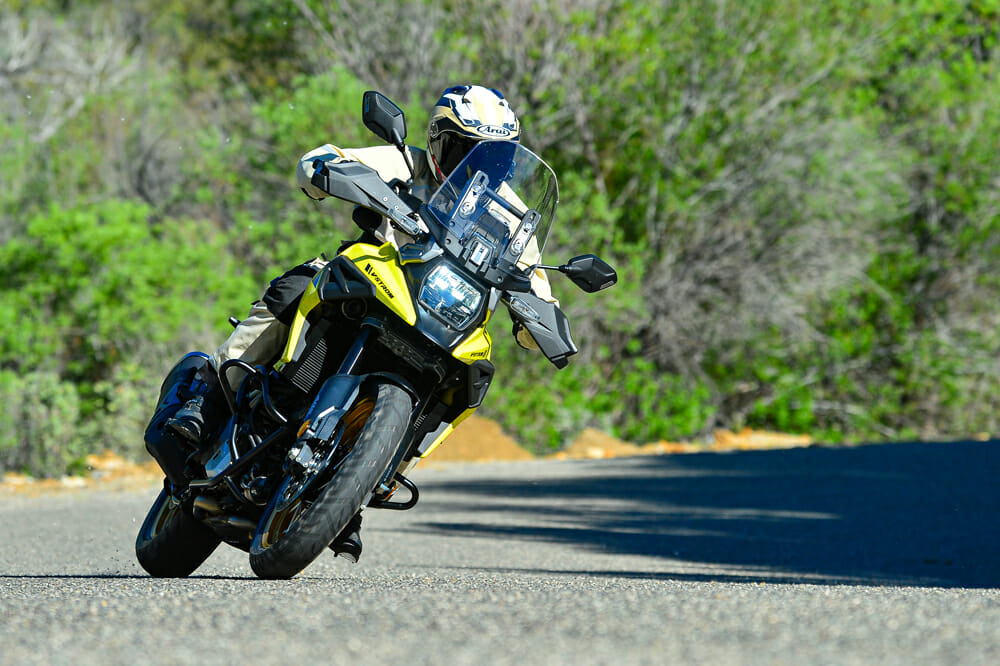 An assortment of rider aids is part of the Suzuki Intelligent Ride System (S.I.R.S.), which includes lean-sensitive traction control, with three options (including off).
An assortment of rider aids is part of the Suzuki Intelligent Ride System (S.I.R.S.), which includes lean-sensitive traction control, with three options (including off).
You’ll easily notice the difference between the three engine modes. “B” seems to find the happy medium between the noticeably more aggressive and abrupt “A” mode and the mellower “C” mode. However, all three have their usefulness, but B mode is excellent all-around and was where I left it most of the time.
Throttle response in all modes is superb; there are no hiccups or surprises anywhere. Same when it comes to shifting the six-speed transmission. Gear changes require just a light nudge on the shifter, and the slipper clutch ensures that it stays that way when things get hot and heavy on the twisties.
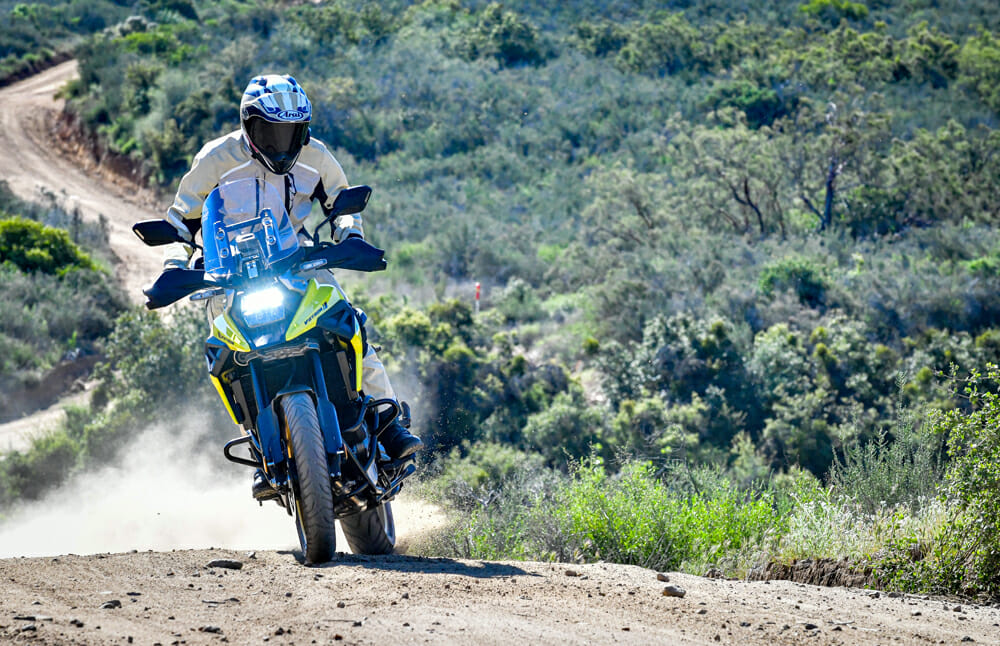 Luckily, traction control can be easily switched off so you can do fun stuff like this. ABS, however, can’t be turned off.
Luckily, traction control can be easily switched off so you can do fun stuff like this. ABS, however, can’t be turned off.
Braking from the front Tokico four-piston monobloc disc brake and rear Nissin 2-piston caliper brake is plenty strong. The cornering/combined ABS (which is lean sensitive) offers two-way intervention adjustability but, unfortunately, cannot be switched off. That is a bummer, in my opinion, at least make it so you can switch off the rear ABS.
Suspension is quite good for the pavement and still does a fine job soaking up bumps on those neglected pothole-filled back roads with loose rocks. However, it blows through its six-plus inches of wheel travel quickly and rather easily on bumpy dirt roads. It’s best to steer clear of rough dirt roads and trails all together on the V-Strom, the stock street-biased tires, under-sprung suspension (for these conditions), low six inches of ground clearance and exposed oil filter don’t bode well on anything more than well-maintained and perfectly groomed dirt roads. At least on full dirt you can turn off traction control.
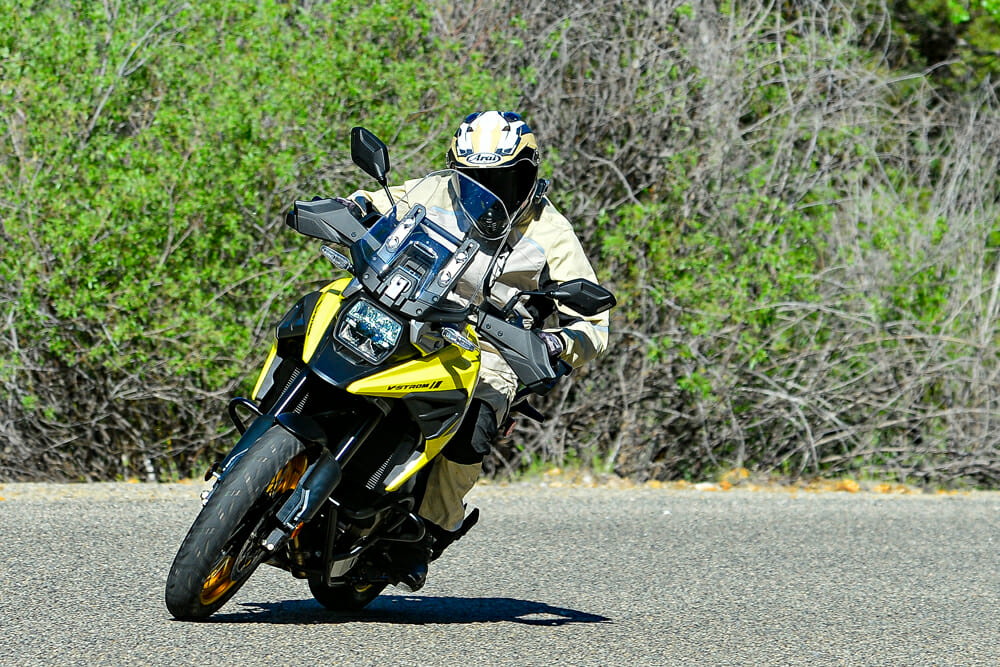 There are three V-Strom 1050 versions to choose from: standard, XT, and XT Adventure. The XTs come in the cool colors, the standard and XT Adventure come in black only.
There are three V-Strom 1050 versions to choose from: standard, XT, and XT Adventure. The XTs come in the cool colors, the standard and XT Adventure come in black only.
However, the V-Strom’s low 33-inch seat height inspires confidence in case you do find yourself caught on a tougher-than-expected fire road, or even on a crowded parking lot for that matter to put your feet down to keep from tipping over. At a claimed 566 pounds, the V-Strom is not a light motorcycle but doesn’t feel too hefty it as long as you’re moving and are on solid ground.
All of the electronics and dash functions (trip, odo, etc.) are controlled via a small switchblock on the left handlebar, which is easy to learn and negotiate, though the LED instrument is a little tough to read. A TFT display would’ve been a lot nicer. The new windscreen works well and is adjustable through a range of two inches via a lever in front of the screen, which means you have to get off the bike to access it. That wasn’t a big deal for me but might be for some. Behind the screen (close to the rider) is an accessory bar for mounting things like a GPS or smartphone, which can be kept charged via a new USB port attached on the left side of the dash. A 12-volt socket can be found under the seat, as well. Speaking of the seat, it is, as mentioned, adjustable, but requires tools and a bit of time to get the job done. At first, I thought that was a pain, but really, how often do you have to adjust the seat? Levers are also adjustable, but no tools are required.
The new LED headlight does a great job lighting up the road, though the headlight itself looks a little dated.
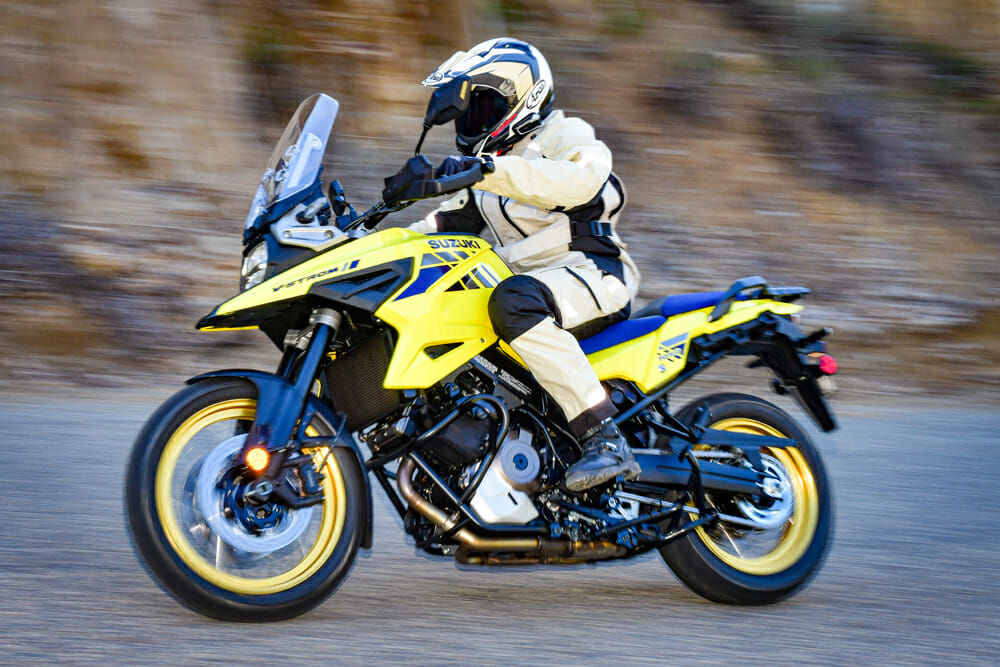 Suzuki did a good job hiding the large 5.3-gallon fuel tank, you hardly know it’s there.
Suzuki did a good job hiding the large 5.3-gallon fuel tank, you hardly know it’s there.
Overall, the revamped V-Strom 1050 is an improved motorcycle, that is, if you like more power and having plenty of rider aids that have been added or enhanced. Not to mention, there are the improved looks, though some still question the V-Strom’s notorious “beak.” (The V-Strom has always invited debate as to its look, right from day one.) But the old-school V-Strom of the past is now more refined and performs better, and it’s just as well-mannered and a joy to ride as ever. There isn’t much not to like about the new V-Strom, but there are a few things at least for me. I think the ‘Strom is in desperate need of a skid plate, and you should have the option of turning off ABS, at least in the rear. A TFT display should be a given, as well. And, there are no small compartments to stash a wallet or phone. My second purchase after a skid plate would be heated grips. And, no, I wouldn’t step up to the XT Adventure just to get the hand warmers, either. Besides, I’m not much for panniers anyway, and black doesn’t do the ‘Strom justice as the yellow and orange XTs do.
But even with these nitpicks, the V-Strom is an impressive all-around motorcycle with good value.CN
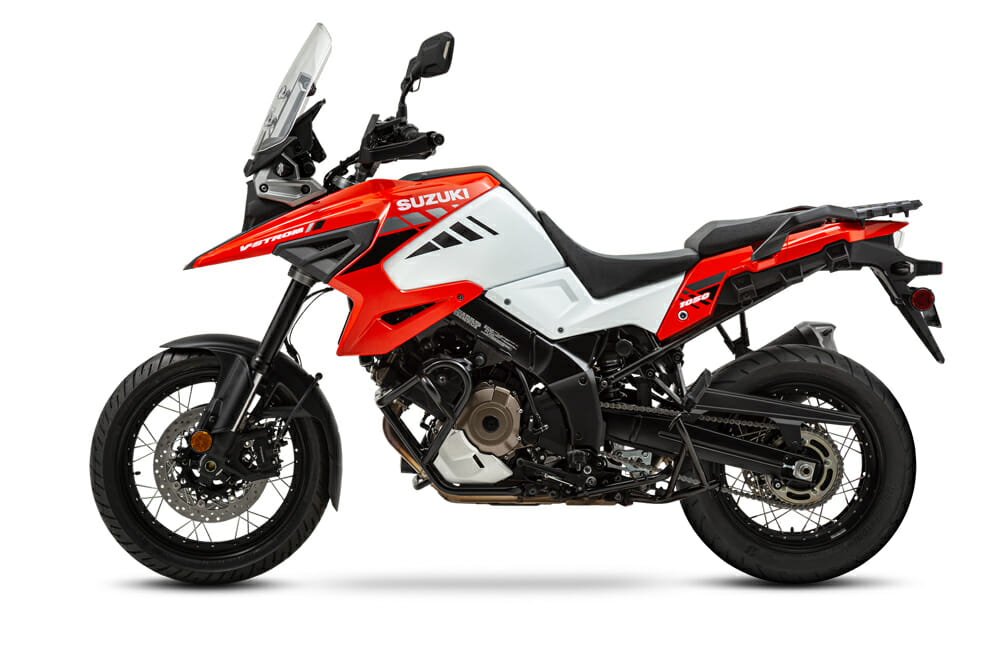
2020 Suzuki V-Strom 1050XT Specifications
|
|
| MSRP: |
$14,799 |
| Engine: |
Liquid-cooled, 4-stroke, DOHC, 90° V-twin |
| Displacement: |
1037cc |
| Bore x Stroke: |
100 x 66mm |
| Compression Ratio: |
11.5:1 |
| Horsepower (claimed): |
106 hp at 8500 rpm |
| Torque (claimed): |
73.75 lb-ft at 6000 rpm |
| Fuel System: |
Fuel injection, 10-hole injector, 49mm throttle body, Ride-by-Wire equipped |
| Rider Aids: |
Cruise control, traction control, three-mode Drive Mode, Motion Track Anti-Lock Brakes, Low RPM Assist, Suzuki Clutch Assist System (SCAS), Hill Hold Control System, Slope Dependent Control System, Load Dependent Control System |
| Ignition: |
Electronic (transistorized) |
| Headlight: |
LED |
| Taillight: |
LED |
| Starting System: |
Electric |
| Lubrication: |
Wet sump |
| Clutch: |
Wet, multi-plate, slipper |
| Transmission: |
6-speed, constant mesh |
| Final Drive: |
Chain, O-ring, RK525 |
| Frame: |
Twin-spar, aluminum; swingarm, aluminum |
| Front Suspension: |
Inverted telescopic fork, fully adjustable |
| Rear Suspension: |
Single shock, link, fully adjustable |
| Front-Wheel Travel: |
6.3 in. |
| Rear-Wheel Travel: |
6.3 in. |
| Front Brake: |
Tokico, 4-piston calipers, 310mm twin floating disc, with linked ABS |
| Rear Brake: |
Nissin, 2-piston, 260mm single disc, with linked ABS |
| Front Tire: |
110/80R19 in. Bridgestone Battlax Adventure A4 |
| Rear Tire: |
150/70R17 in. Bridgestone Battlax Adventure A4 |
| Wheels: |
D.I.D-supplied spoke-style wheels with aluminum rims |
| Fuel Capacity: |
5.3 gal. |
| Wheelbase: |
61.2 in. |
| Ground Clearance: |
6.3 in. |
| Seat Height: |
33.5 in. |
| Weight (curb, claimed): |
544.6 lbs. |
| Colors: |
Pearl Brilliant White/Glass Blaze Orange / Champion Yellow No. 2 |
